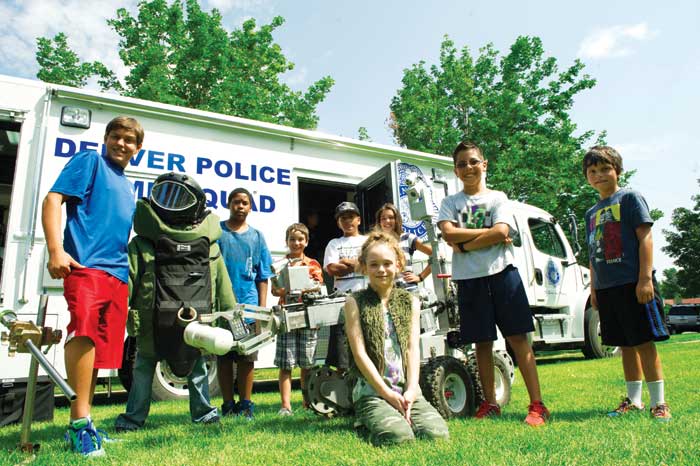
At the McAuliffe celebration after the bike ride are (back row from left): Nicholas Michas, 9th grade DSST: Cole; Tyree Durst, 6th grade McAuliffe (in bomb squad gear); Jabraun Durst, 8th grade Hill; Alexander Michas, 4th grade Izzie B; DeAndre Long, 6th grade McAuliffe; Sophia Michas, 7th grade McAuliffe; Joaquin Casias, 6th grade McAuliffe; Toby Snyder, 3rd grade Swigert and (center front:) Veronica Hearne, 6th grade McAuliffe. Front Porch photo by Laura Mahony.
The new 26th Ave. bike path is making it possible for Stapleton and east Park Hill students to have a safer commute as they ride to the new McAuliffe International School location at 26th and Holly. Principal Kurt Dennis estimates that about 200 of the school’s 724 students ride their bikes. “We had to get more bike racks,” he says. He adds that all the kids are wearing helmets, even skateboarders, and one of the first subjects at school meetings each year is bicycle safety.
But a new location and a new bike path aren’t the only changes at McAuliffe this year. The approach is the same, but scale has changed—the school has almost doubled in size, to 724 students, and is at full capacity in its first year.
Scaling up has offered lots of new opportunities, says Dennis, as well as a few challenges. The biggest challenge was planning for the movement of students between classes in the large four-floor building (including basement). Dennis says he and his administrative staff spent much of the week prior to the first day of school “walking the building and figuring out where we wanted kids going, which stairwells we wanted them to use and how they get from one space to the next with the least amount of inconvenience.”
He points out that when kids go from the basement to the 3rd floor, “It’s a decent haul.” The first couple of days there was a lot of giving kids directions and support in the hallways but by the second week of school the kids had adapted.
With the challenges mostly handled by pre-planning and assisting students during their first week of school, Dennis describes the benefits that came with the move to the Smiley building.
Shared Boundary
Dennis believes the shared boundary policy for Stapleton and Park Hill is working in all five middle schools. “For the most part, all the schools are representative of the cross section of NE Denver.” His observation at McAuliffe: “Right away the kids seemed to embrace the whole idea and make new friends. It’s fun to see.
“It’s really cool seeing the kids from all over NE Denver converging on this campus whether on foot, by bike, or by bus. It’s pretty special having so many kids here from all over NE Denver.”
And Dennis adds that the shared boundary has dramatically changed the capture rate for Park Hill kids attending school in their home boundary area. “For the folks that live in Park Hill, 74 percent of the kids are attending middle school in their home attendance area where in the past that number was 18 percent. In one year we captured almost 60 percent more kids.”
Daily Teacher Collaboration
Dennis says a big benefit of the larger school is that they are able to schedule a planning and collaboration time every day for the core team teachers at each grade level (math, social studies and language arts).
Having more specials teachers allows an entire grade level to go to specials at one time. For example, all 6th-graders go to electives the last period of the day, leaving their core team of teachers free to meet and collaborate on lesson planning and talk about kids—and teachers love it, says Dennis. “Feedback in the last two years was that teachers wanted more collaboration time. Now they’re getting that for 80 minutes a day and it’s helping improve instruction and it’s improving collegiality and professional relationships.”
Common Core
The teacher collaboration time has been especially helpful with the changes brought by Common Core. Dennis says the school’s approach to teaching reading, writing and math is changing fairly significantly to align with Common Core standards. “Having thought partners when you’re looking at new standards and how you’re going to approach those standards is important—and fortunately we have the scale now to do that work effectively.”
Dennis explains that IB in middle school is really more an approach to learning and not so much a curriculum, like it is for juniors and seniors in high school. “For us we’re still administering the same approach to learning and instruction that we always have, but the skills and the content have adjusted,” with the focus on Common Core.
Specials
“This facility, having been designed 85 years ago to serve a true middle-school model, is much better aligned with our needs.”
Having a 19-acre campus offers playing fields to run multiple PE classes outside at the same time. “Two full-sized playing fields, baseball and softball fields, and a tennis court make it almost like an athletic complex.” He adds that having more teams means McAuliffe is able to accomodate more kids who attend other middle schools that don’t have a particular sport—they can play their sport of choice at McAuliffe while attending their own school.The school has three large engineering labs in the basement that used to be the woodshop and industrial arts classrooms in the old Smiley. They have been renovated into engineering labs where the school offers courses in robotics, design, environmental architecture and aerospace engineering. The three engineering teachers teach only engineering classes and all have had careers in engineering. “Almost every kid in our school takes engineering,” says Dennis.
With an auditorium, Dennis says, the school has scaled up opportunities in the performing arts with eight classes in theatre, a choir, two orchestras, and three bands. The larger number of students has allowed the school to hire full-time teachers for drama, art and music.




0 Comments